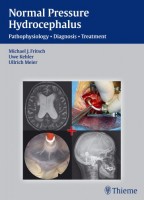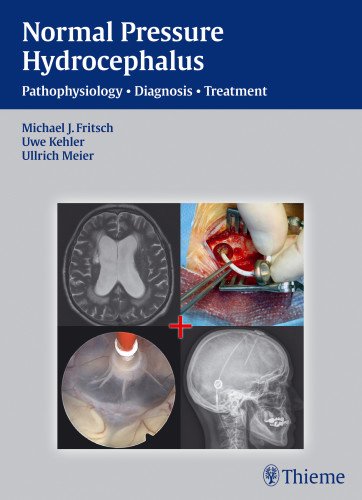 Editors: Michael J. Fritsch, MD; Uwe Kehler, MD, PhD; and Ullrich Meier, MD, PhD. With contributions by Johannes Lemke and Christoph Miethke.
Editors: Michael J. Fritsch, MD; Uwe Kehler, MD, PhD; and Ullrich Meier, MD, PhD. With contributions by Johannes Lemke and Christoph Miethke.
Publisher: Thieme Publishers
Book Review by: Nano Khilnani
Hydrocephalus is an abnormal increase in the amount of cerebrospinal fluid within the cranial cavity that is accompanied by expansion of the cerebral ventricles, enlargement of the skull, especially the forehead, and atrophy of the brain.
For those who want to learn more about this condition we urge them go online, type in “hydrocephalus” in the search field, and look at the pictures presented. A picture is worth a thousand words, as has been said often, so this is a quick means to begin learning about it.
Normal pressure hydrocephalus or NPH is a more specific type of this disorder that is characterized by the enlargement of the ventricles in the brain and the Hakim triad (named after Salomon Hakim who first described its clinical picture in his 1957 degree thesis) which consists of:
- Gait impairment: a broad-based, shuffling magnetic gait
- Mental deterioration or dementia
- Urinary incontinence
Some other signs of NPH are comorbidities, dizziness, extended need for sleep, headaches, imbalance, impairment of sexual function, large head circumference, psychiatric syndromes, and vertigo.
There are two subtypes of NPH: primary or idiopathic NPH (iNPH) and secondary NPH (sNPH). iNPH is a disease of the elderly population, typically beginning to occur between the ages of 65 and 70. The causes of primary and iNPH remain unclear.
There are several neurosurgical techniques for mitigating the effects of NPH. One of the most frequently used ones is shunting. The authors write that the “clinical symptoms can be improved by the shunting of cerebral spinal fluid, which is temporarily achieved via lumbar puncture or external lumbar drain, or permanently achieved via shunt implantation.”
A shunt, as described on the website of Medtronic, a company that sells medical devices, usually consists of two catheters and a one-way valve. The valve regulates the amount, flow direction, and pressure of cerebrospinal fluid out of the brain’s ventricles.
As the pressure of cerebrospinal fluid inside the brain increases, the one-way valve opens and the excessive fluid drains to the downstream cavity.
Typically, the fluid gets “shunted” or moved using the following shunt types:
- A ventriculo-peritoneal shunt moves fluid from the ventricles of the brain to the abdominal cavity
- A ventriculo-atrial shunt moves fluid from the ventricles of the brain to a chamber of the heart
- A lumbo-peritoneal shunt moves fluid from the lower back to the abdominal cavity
This is a rare book that takes a fairly comprehensive (extensive) and detailed (intensive) look at NPH. The coverage of this subject is provided by the three authors and contributors to this book with the presentation and discussions of the following aspects of this disease in its 17 chapters:
- Introduction
- Epidemiology of Idiopathic Normal Pressure Hydrocephalus
- History
- Clinical Characteristics and Differential Diagnosis
- Pathophysiology
- Noninvasive Diagnostic Work-up
- Imaging
- Invasive Diagnostic Work-up
- Shunt and Valve Technology
- Shunt and Valve Settings
- Surgical Technique
- Endoscopic Third Ventriculostomy in Normal Pressure Hydrocephalus
- Scales and Scores
- Follow-up Management of Idiopathic Normal Pressure Hydrocephalus
- Complications
- Prognosis
- Summary and Future Perspectives
The material in the chapters is presented well, with brief but succinct discussions of topics and some graphics. For example in chapter 4 – Clinical Characteristics and Differential Diagnosis – the author Dr. Uwe Keller provides the following topics (with symptoms, diagnosis, and treatment for each one of them):
- Natural History
- Symptoms of iNPH
- Main Symptoms (gait disturbance, incontinence, dementia)
- Other Symptoms (headache, psychiatric syndromes, dizziness/vertigo, extended need of sleep, large head circumference, impairment of sexual function, comorbidities)
- Differential Diagnosis
- Secondary NPH and Chronic Obstructive Hydrocephalus
- Parkinson Disease
- Alzheimer Disease
- Binswanger Disease
- Brain Atrophy
- Cervical Myelopathy
A Summary of the chapter and a very useful References section with many other materials, is provided in the end.
This is a valuable book on normal pressure hydrocephalus or NPH and related diseases. It is fairly comprehensive and written by five specialists who have specific knowledge on it. They have conducted a lot of research on NPH and other similar conditions and have numerous years of experience in their diagnosis and proper treatment.
This book provides much information on clinical characteristics, diagnostic tests, pathophysiology, radiographic findings, signs and symptoms, state-of-the-art treatment techniques and much more. If you do not know much about this specialty or already know a lot about it, this is the book for you.
Authors:
Michael J. Fritsch. MD is Chairman of the Department of Neurosurgery at Dietrich-Bonhoeffer-Klinikum in Neubrandenburg, Germany.
Uwe Kehler, MD, PhD is Professor and Chairman of the Department of Neurosurgery at Asklepios Klinik Altona in Hamburg, Germany.
Ullrich Meier, MD, PhD is Professor and Chairman in the Department of Neurosurgery at Unfallkrankenhaus Berlin in Berlin, Germany.
Contributors:
Johannes Lemke, MD is Senior Neurosureon in the Department of Neurosurgery at Unfallkrankenhaus Berlin in Berlin, Germany.
Christoph Miethke, MEng is President and Director of Research and Development at Christoph Miethke GmbH & Co. in Potsdam, Germany.







